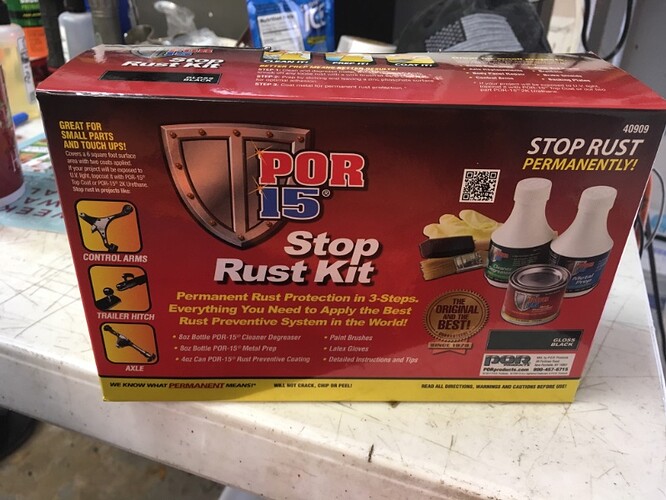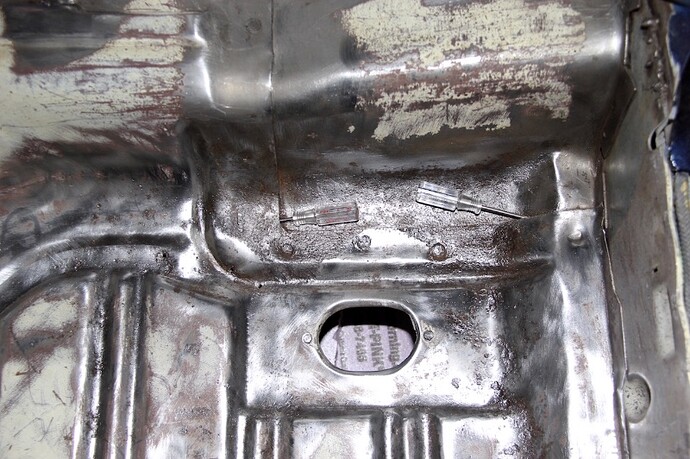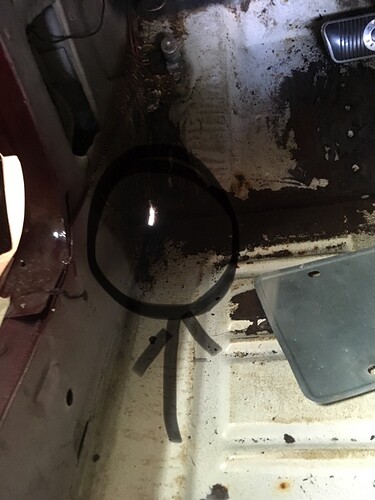I am preparing my floor to coat with epoxy primer. I have removed all the old seam sealer and there is bare metal underneath which is largely rust free. Should I apply the primer first and then apply the seam sealer? Not sure how the epoxy will work over the sealer. Or, should I apply a etching primer on the bare metal, then epoxy, then sealer?
Look how well the original process worked over the past fifty years. Why would you not want to do exactly the same thing?
Yea, I think it’s important to put some sort of etching procuct on that bare metal. They make primer for that is self etching. Im replacing carpet in my 67…purchased a POR 15 kit from Advanc auto. Comes with degreaser, metal prep (etching product) and POR ( paint over rust) product.
apply a etching primer on the bare metal, then epoxy, then sealer.
yes,primer then seam sealer.
Here is the brand that I use and recommend. It is applied directly to bare metal and provides complete protection from corrosion.
OEM recommended
Direct to metal
Paintable immediately
Remains flexible without shrinking or cracking
Colors match many OEM sealers
Optimal working time
Corrosion resistant
Resistance weldable
Excellent adhesion
The original method wasn’t real good(cars rusted in the north when they were 5 years old)! Modern cars are primed(2 part epoxy) then seam sealed with a 2 part product. And they last much longer even in northern climates. We have better products and methods available in 2018,so take advantage of them!
And if you are using a true epoxy primer? You don’t want to spray it over etch primer. What is the brand and part number of the primer you have?
Trying to follow along here because I am up to the same thing on my 67. Are we talking about seam sealer brushes everywhere or just along the panel seams where it is heavy from factory. They make a brushable product and a caulk gun product. In my scenario I have some heavy and some light rust. I don’t want to cut and weld now even though one spot has a few pinholes under back seat. . I plan to use Evaporust liquor on all visible rust and let it all dry. Then use the Three part kit from POR 15…clean, etch, and then brush on the coating. After all that I would apply the seam sealer…if I got this wrong please suggest how to go.
I didn’t know Evaporust was a liquor.
My bad…I will be brushing on the liquid Evaporust. Drinking liquid later in the day.
I think I am going to take Royce’s advice and put the seam sealer direct to the bare metal. It is bright and shiny almost everywhere under the old sealer. I will apply the epoxy over the sealer. I am using 3M urethane seam sealer. I will be using Americoat 235 epoxy. Thank you for the input.
Do the two openings (indicated with the screw drivers) remain open for drainage or do they need to be filled with seam sealer?
Don’t think you’ll find that seam sealer is going to stick very well to the POR very well. Use the POR a couple of times - would never use it again on anything but a rusty work truck. Just my opinion
As for the “drain holes” you opened up (not there originally) you run the risk now of trapping moisture in those overlaps or sealing them and you can’t be certain of either. After flushing with evapo rust I would try and work some sealer in to the gabs then hammer and dolly the panels together, wipe off the excess then epoxy coat and put sealer back as it was originally,
I’ve used small fountain pumps and a catch basin to flow evapo rust for 24 hours in situations like yours where rust had developed between panel overlaps and on uni-body panels stuff works too slow (though they do make a jell now) for just applying it with a brush for an hour or two
I noticed on my 67 I have what appears to be a drain hole? In front floor pan? Or should this be sealed…? Sorry never done this before. I’m shining a flashlight up through gap and I circled it
Not typical so you need to check to see if its a rust through, damage or something else then fix or seal it. Check from below also
The two gaps I inserted the screw drivers into are not rusted out holes. They are formed into the other floor panel and are the same on both sides. The gap is roughly 1/4" and nearly 1" long. Perhaps a replacement pan was installed that does not fit right?
The rust comment in reply #16 was in reference to the front floor board picture and question. Doesn’t look like the floor has been replaced in your first picture you can always check for non-factory like welds (few reproduce them correctly) and check for the original panel date on the floor panel.
This is simply typical workmanship on the line. A gap like that is larger than normal but not unheard of. Like you say, just fill it with seam sealer. I am sure the factory did or should have originally.
Agree completely on the POR. It might be useful for a northern daily driver to literally paint over rust. It doesn’t stick well to clean metal. Weird stuff.


